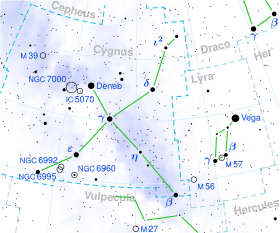| Observation data Epoch J2000.0 Equinox J2000.0 | |
|---|---|
| Constellation | Cygnus |
| Right ascension | 19h 17m 06.16865s[1] |
| Declination | +53° 22′ 06.4534″[1] |
| Apparent magnitude (V) | 3.814[2] |
| Characteristics | |
| Spectral type | G9 III[3] |
| U−B color index | +0.767[2] |
| B−V color index | +0.965[2] |
| Astrometry | |
| Radial velocity (Rv) | −29.36±0.09[4] km/s |
| Proper motion (μ) | RA: +60.07[1] mas/yr Dec.: +122.83[1] mas/yr |
| Parallax (π) | 26.27 ± 0.10 mas[1] |
| Distance | 124.2 ± 0.5 ly (38.1 ± 0.1 pc) |
| Absolute magnitude (MV) | +0.84[4] |
| Details[4] | |
| Mass | 2.35±0.12 M☉ |
| Radius | 8.77±0.05[5] R☉ |
| Luminosity | 46.8+5.7 −5.1 L☉ |
| Surface gravity (log g) | 3.02±0.04 cgs |
| Temperature | 5,021±12 K |
| Metallicity [Fe/H] | 0.1 ± 0.02 dex |
| Rotational velocity (v sin i) | 1.08±0.28 km/s |
| Age | 813+164 −137 Myr |
| Other designations | |
| Database references | |
| SIMBAD | data |
Kappa Cygni, Latinized from κ Cygni, is a star in the northern constellation of Cygnus. It has an apparent visual magnitude of 3.8,[2] which is bright enough to be seen with the naked eye. In the constellation, it forms the tip of Cygnus's left wing.[6] The radiant of the minor Kappa Cygnids meteor shower is located about 5° north of this star.[7]
Examination of this star's spectrum show it to match a stellar classification of G9 III,[3] with the 'III' luminosity class revealing that it has consumed the hydrogen fuel at its core and expanded into the giant star stage of its stellar evolution. It is known to vary in luminosity, but only by about 0.01 to 0.02 magnitudes.[8] Despite being younger than the Sun with an age of 800 million years,[4] it has reached its current evolutionary stage because more massive stars evolve faster. Kappa Cygni has expanded to 8.77 times the Sun's radius[5] and is glowing with 47 times the Sun's luminosity. The outer envelope has an effective temperature of 5,022 K,[4] giving it the yellow-orange hue of a star near the transition from a G- to a K-type classification.[9]
References
[edit]- ^ a b c d e van Leeuwen, F. (November 2007), "Validation of the new Hipparcos reduction", Astronomy and Astrophysics, 474 (2): 653–664, arXiv:0708.1752, Bibcode:2007A&A...474..653V, doi:10.1051/0004-6361:20078357, S2CID 18759600
- ^ a b c d Jennens, P. A.; Helfer, H. L. (September 1975), "A new photometric metal abundance and luminosity calibration for field G and K giants.", Monthly Notices of the Royal Astronomical Society, 172 (3): 667–679, Bibcode:1975MNRAS.172..667J, doi:10.1093/mnras/172.3.667
- ^ a b Morgan, W. W.; Keenan, P. C. (1973), "Spectral Classification", Annual Review of Astronomy and Astrophysics, 11: 29–50, Bibcode:1973ARA&A..11...29M, doi:10.1146/annurev.aa.11.090173.000333
- ^ a b c d e Deka-Szymankiewicz, B.; Niedzielski, A.; Adamczyk, M.; Adamów, M.; Nowak, G.; Wolszczan, A. (2018-07-01). "The Penn State - Toruń Centre for Astronomy Planet Search stars. IV. Dwarfs and the complete sample". Astronomy and Astrophysics. 615: A31. arXiv:1801.02899. Bibcode:2018A&A...615A..31D. doi:10.1051/0004-6361/201731696. ISSN 0004-6361. Kappa Cygni's database entry at VizieR.
- ^ a b Baines, Ellyn K.; et al. (2018), "Fundamental Parameters of 87 Stars from the Navy Precision Optical Interferometer", The Astronomical Journal, 155 (1), 30, arXiv:1712.08109, Bibcode:2018AJ....155...30B, doi:10.3847/1538-3881/aa9d8b, S2CID 119427037.
- ^ Consolmagno, Guy; Davis, Dan M. (2011), Turn Left at Orion: Hundreds of Night Sky Objects to See in a Home Telescope - and How to Find Them (4th ed.), Cambridge University Press, p. 134, ISBN 978-0-521-15397-3
- ^ Stegmüller, Wolfgang (1979), The structuralist view of theories: a possible analogue of the Bourbaki programme in physical science, Astronomers' Observing Guides, Springer, p. 82, ISBN 0-387-09460-1
- ^ Adelman, Saul J. (2001), "On the Photometric Variability of Red Clump Giants", Baltic Astronomy, 10 (4): 593–597, Bibcode:2001BaltA..10..593A, doi:10.1515/astro-2001-0404
- ^ "The Colour of Stars", Australia Telescope, Outreach and Education, Commonwealth Scientific and Industrial Research Organisation, December 21, 2004, archived from the original on March 18, 2012, retrieved 2012-01-16
